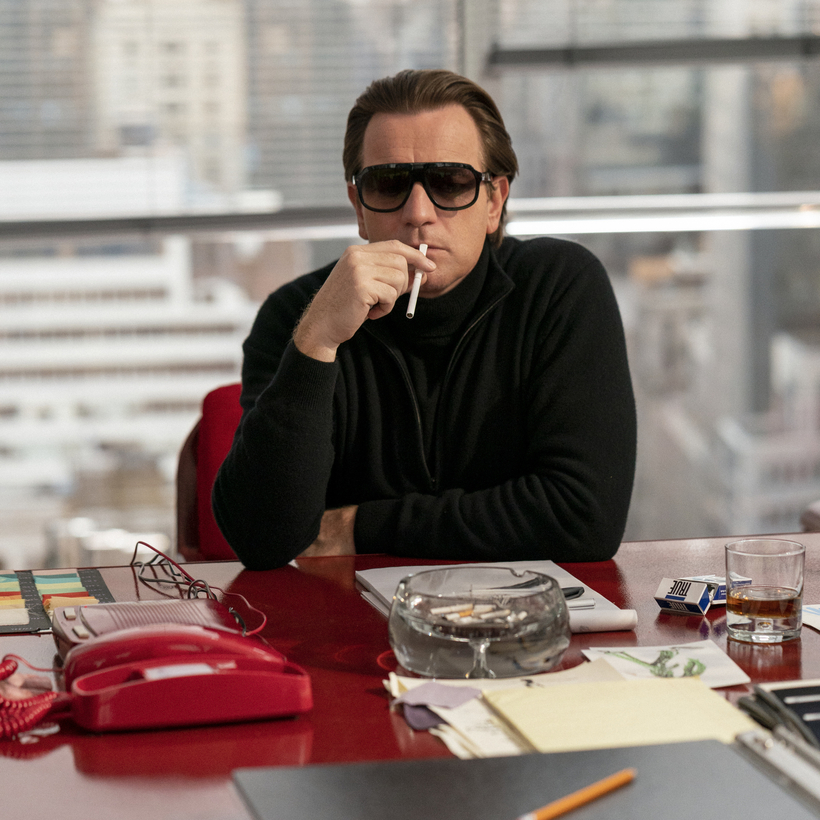Tall and lean, in trademark black turtleneck and black slacks, his inviolable jaw always lifted as if addressing the future, the American fashion designer Halston stood like a capital I come to life, ego personified. Fashions come and fashions go, but the name Halston remains immortal because of this indelible imprint we carry of him in our heads—icons have seldom looked as iconographic.
So when word descended from Mount Olympus that Ewan McGregor had been chosen for the title role of Halston, the Ryan Murphy–produced, five-part Netflix series based on Steven Gaines’s biography Simply Halston: The Untold Story, some of us worry-bees wondered, Could he project the height and hauteur, the chess-knight gleam, of the original item? McGregor’s most familiar roles, in Trainspotting and the Star Wars prequels, weren’t exactly drenched in opulence.
Whatever doubts one might have harbored are dissolved with the first rounded vowels out of McGregor’s mouth, the maestro flair of his wrist as he cocks a cigarette and holds forth. McGregor is no Halston look-alike, but he assumes inner possession of the Halston mystique and brings it to defiant life. Halston could cut and drape fabric like a Zen master, and in close-ups McGregor’s concentration on fabrics, the shapes of perfume bottles, the cinch of a belt, conveys an artist’s acquisitional eye that sees in an extra dimension the rest of us are denied.

The casting of the remainder of Halston’s constellation could not be bettered: Rebecca Dayan as model and jewelry designer Elsa Peretti; David Pittu as illustrator Joe Eula; Kelly Bishop as Eleanor Lambert; Krysta Rodriguez as Liza Minnelli, for whom there is no more forgiving friend to flawed man; Vera Farmiga as the perfumer Adele; and Gian Franco Rodriguez as Halston’s boyfriend, the hustler and window designer who called himself Victor Hugo (“Huge-o”), a firecracker in a jockstrap.
After a dowdy year in lockdown and sensual deprivation, our hunger for glamour and reckless excess is so avid that Halston’s injections of extravagance and decadence feel restorative, like being showered with confetti and champagne foam beneath a disco ball.
Pillbox Popper
Born Roy Halston Frowick in 1932 and raised here and there in the Midwest, Halston was a classic American case of self-reinvention, a product of the postwar boom that gave us Andy Warhol and Mad Men’s Don Draper. He pared away the inessentials until he achieved the pure expression of his willful ambition and persona.
Postwar Manhattan was the perfect launchpad for such enigmas. Halston begins in 1961, when the pillbox hat he designed for Jacqueline Kennedy brings the gloved ladies flocking to Bergdorf Goodman. Bergies! We’ve missed you so.
When women’s hats become passé, thanks to Jackie (who stopped wearing hats, Halston fumes, “so she wouldn’t ruin that awful gigantic hairdo of hers”), he rebounds with the fashion brain wave of a line of shirtwaist dresses done in Ultrasuede, which make his name anew.
Episode Two, devoted to Halston’s improbable triumph in “The Battle of Versailles,” is where the series truly kicks into rhythm, when Halston and entourage arrive at the airport in slow motion to the thump of David Bowie’s “The Jean Genie” as rival designers Bill Blass, Stephen Burrows, and Oscar de la Renta and their entourages converge upon one another at the arrival gate like the news teams in Anchorman, ready to rumble.

Victorious at Versailles, Halston achieves the escape velocity into wealth and celebrity that enables him to fulfill his every whim and fantasy, while still working himself and his staff ragged. The spectacular mirrored palace of the Halston workroom and showroom on the 21st floor of Midtown’s Olympic Tower and the funky basement at Studio 54 become the twin poles of his existence: the empyrean and the underworld. He becomes a household name, a ubiquitous designer brand (cleverly shown here with an ad montage of proliferating Halstons), and a princely eminence, appearing on The Love Boat with a mini-squad of “Halstonettes.” How serene he appeared to reign, but no one can keep vampire hours for too long with impunity, not even a vampire.
Under the grinding pressures of being creative on schedule for corporate overlords and impressing the fickle fashion press, which to him justify the splurges on orchids and lavish flights to Paris, Halston begins to implode, his imperium to crumble. The snowbanks of cocaine he nosed up certainly didn’t help, nor did the steady trudge of rough trade into his modernist lair on East 63rd.
It would have been easy to turn Halston’s parabolic rise and downfall into a morality tale, a skyscraper parable about the perils of hubris, but Halston lets its story play out without melodrama or twenty-twenty hindsight.
Uncharacteristically for a Ryan Murphy production, the series, directed with dispatch and tact by Daniel Minahan, under-sensationalizes the lurid excesses of Halston’s life in its meteoric descent. For instance, the scene in which Elsa Peretti lashes out at Halston in Studio 54 is less feral than Bob Colacello’s eyewitness account in Holy Terror: Andy Warhol Close Up (“She fell to the floor amid shards of glass and started crying”), and Victor Hugo’s destructive, exhibitionist antics, bad as they are here, could have been dialed up even louder based on what we know from the compendious Halston–Warhol–Studio 54 literature. Even when Halston is being impossible and spitting invective, we’re aware of the fear and frailty underneath, the rising, scraping desperation.

The heart of Halston lies in the intimate scenes with Liza and, later, with Martha Graham (Mary Beth Peil), where the designer is able to drop his theatrical airs and talk equal to equal, legend to legend, about what’s eating him inside.
Having lost his business, his lordly offices, even the commercial use of his name, Halston finds a grace note of redemption designing the dance costumes for Graham’s Persephone, the positive reviews proof that, whatever else has been taken from him, his talent still abides. Diagnosed with AIDS, Halston sells his Manhattan apartment and Montauk house and spends the remainder of his days driving up and down the Pacific Coast Highway in his Rolls-Royce convertible. It doesn’t get more F. Scott Fitzgerald than that.
Halston is streaming on Netflix
James Wolcott is a columnist for AIR MAIL

